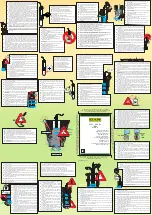
OMF-1
Analog filter Rack
In the AR mode, the output will stay high as long as the gate is active high. In other words
the output is ‘sustained’. Once the gate is turned off and goes low, the output of the EG will
fall.
In the AD mode, the output of the EG will drop as soon as the peak is reached. There is no
sustain and the release mode is started prematurely even if the gate is still high. This
premature release mode is correctly called decay.
AR mode produces sustained effects like an organ. The AD mode produces percussive
sounds like a guitar or marimba.
•
Threshold:
The audio-trigger circuit. The peak level of the audio signal, either the
main input or the ‘side chain’, is analysed in this section. If the audio input is higher
than the level set by the threshold pot, then a gate output is produced that can trigger
the EG if turned on. With the pot set less than fully clockwise, a loud signal is
required to trigger the EG. With it set fully anti-clockwise very quiet sounds will trigger
it. However, setting it too low can cause false triggering. This pot's operation can get
some getting used to. Stick with this, the results are worth it.
The effects of the audio-trigger circuit can be turned off by simply setting the
threshold pot to its most clockwise position. No matter how loud your incoming
signal the audio-trigger circuit will not detect any audio with the pot in this position.
•
LFO:
This little bi-colour LED responds to the output of the LFO. It will gently pulse in
brightness and colour according to the speed of the LFO.
•
LFO rate:
Low frequency oscillator (LFO) frequency. Controls the frequency of the
LFO. From about 0.2Hz (slow) to 30Hz (fast). Great for producing ‘wah-wah’
and trancey swishes when the filter is set to self oscillate.
•
Auto Trig:
LFO trigger. The LFO will trigger the EG automatically. The Trig LED will
flash at the speed determined by the LFO frequency when this is turned on.
•
LFO wave:
This controls the waveform that will modulate the LFO via the LFO depth
control. Triangle or square wave outputs. Triangle will move the cut-off frequency up
and down smoothly, like wah-wah. Square wave will move the cut-off point rapidly
between two points, creating “bip-bip-bip” sounds.
•
LFO depth:
Controls the amount that the LFO can affect the filter.
That completes the overview of the front panel operation.
6



























